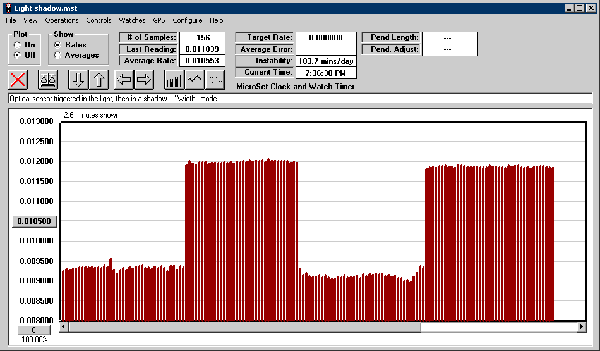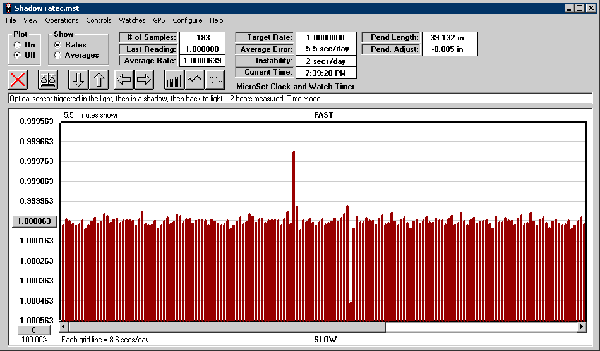|
Measuring Clocks and Watches
Problems with optical sensors But life is never simple in the pursuit of precision. You might say that the whole environment is contaminated by the medium an optical sensor uses. By this I mean light, and an optical sensor can be influenced by ambient light levels. In the worst case, direct sunlight falling on the sensor will prevent it from working at all. Short of this, the amount of ambient light can affect the trip point of an optical sensor. This wouldn’t matter if the light level in the room never changed. But this is not likely without special precautions. There’s a special function in MicroSet (the ”Width” function) that can be used to measure the effect of ambient light. It measures the time an optical sensor is blocked by the pendulum. You can think of this as measuring the size of the shadow cast by the pendulum. The wider the shadow is, the longer the trigger from the sensor is. This graph shows the effect of changing light levels. Each data point indicates how long the sensor trigger was. The clock being measured was in a room brightly lit by a wall of windows. At the beginning of the graph the clock was exposed to the full light of the room. The sensor was triggered for about nine milliseconds, and the red lines in the graph are short. Then I stood in front of the clock and cast a shadow on the optical sensor. Now the trigger lasts for 12 milliseconds, and the red lines are taller. The trigger is longer when the room is darker. This effects the measurement because the reading that precedes the trigger will appear shorter if the trigger is longer. When the shadow is removed, the next reading will appear longer because the trigger is shorter. These effects cancel each other out in the long term, and the changes are usually so gradual as to be imperceptible. But sudden or dramatic changes in light levels can look like inconsistency in the pendulum. Such effects might be common if you were measuring in a room without windows and turned the lights on or off. In this graph the effect of changing light is seen on a rate measurement. On the whole, the rate is relatively consistent across the graph. But there are two anomalous readings near the center. When a shadow was cast, the next measurement appeared too fast, as indicated by the tall red line. When the shadow was removed, the next measurement appeared too slow, indicated by the short red line. These considerations need to be kept in mind when using optical sensors. A similar problem can occur if the pendulum swings in a slight ellipse instead of a straight line. This can happen if the suspension spring is damaged. The pendulum then swings closer to the emitter at some times, and closer to the detector at other times. This changes the trip point of the sensor, and it appears as a small cyclic variation in the rate.
|

